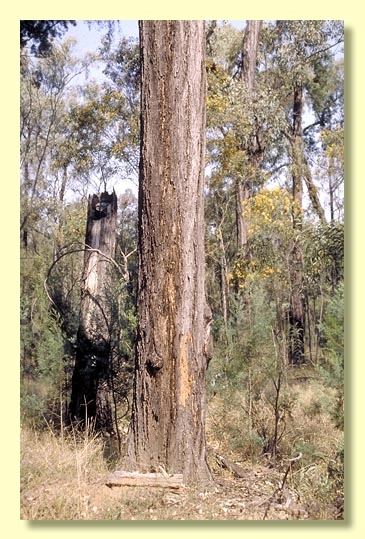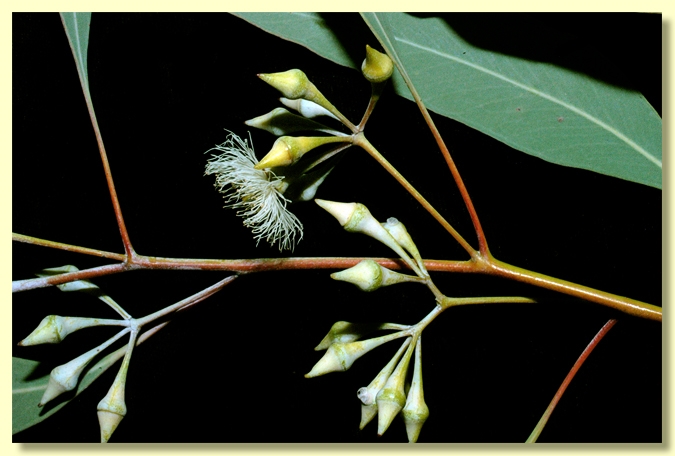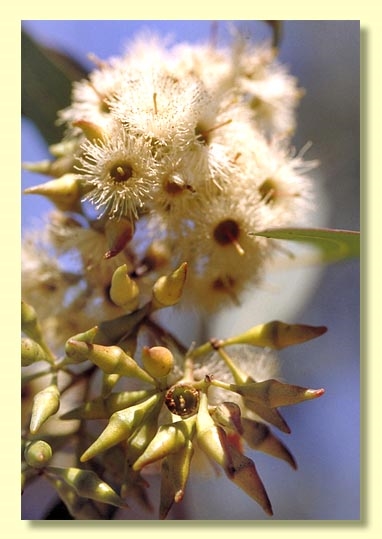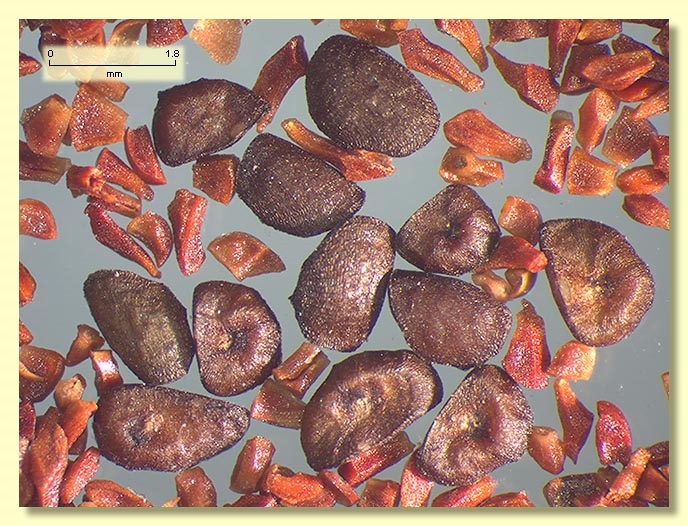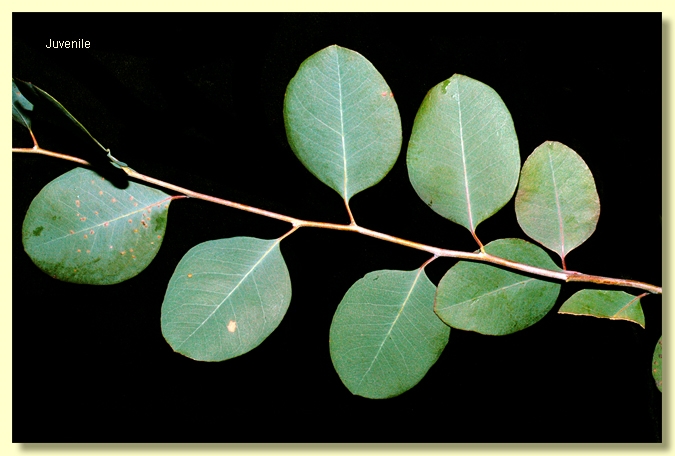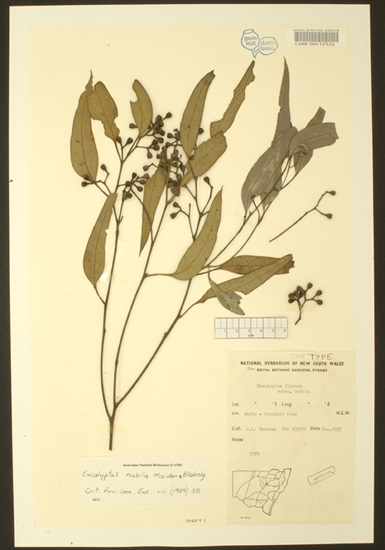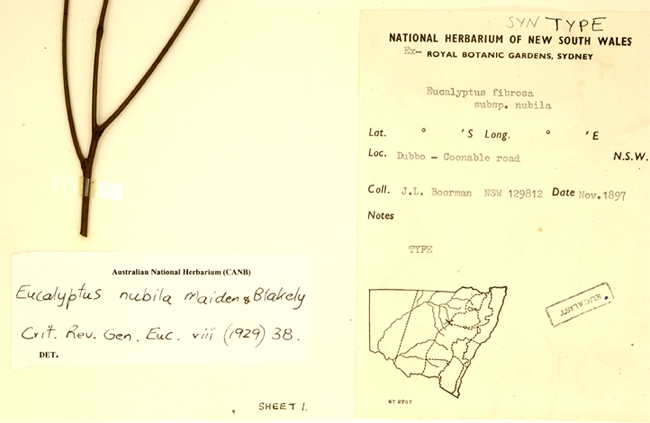Euclid - Online edition
Eucalyptus fibrosa subsp. nubilis
Eucalyptus | Symphyomyrtus | Adnataria | Apicales | Siderophloiae | Subglaucae
Eucalyptus nubilis Maiden & Blakely in J.H.Maiden, Crit. Revis. Eucalyptus 8: 38 (1929), based on E. siderophloia var. glauca H.Deane & Maiden;
Eucalyptus siderophloia var. glauca H.Deane & Maiden, Proc. Linn. Soc., New South Wales 24: 461 (1899). T: Dubbo District, N.S.W, Nov. 1897, J.V.de Couque & J.L.Boorman s.n.; syn: CANB, NSW; Dubbo District, NSW, Nov. 1892, H.Deane s.n.; syn: (?) NSW.
In all earlier editions of EUCLID the name Eucalyptus fibrosa subsp. nubila was used as it reflected common usage. This is here corrected after Bean re-explored the spelling of the subspecific epithet as explained below:
Bean, A.R., (2009) Typification of some names in Eucalyptus (Myrtaceae), Part 1. Telopea 12(3): 312-31. Text: "Johnson (1962) changed Maiden & Blakely's epithet from nubilis to nubila, claiming that the original spelling was "clearly an unintentional error for nubila. Latin nubilus means 'dark or gloomy', reflected in Blakely's English name 'Dusky-leaved Ironbark', while nubilis means 'marriageable', inapplicable here". Johnson further wrote, "Mr H.K. Airy Shaw, of Kew, has expressed the view (in litt.) that 'nubilis' is an unintentional orthographic error which should be corrected." Maiden & Blakely did not comment on the etymology of their epithet, but because Blakely (1934) continued to use the same spelling, we can be sure nubilis was not an 'unintentional error'. Nor is it an orthographic error to be corrected (under Article 60), as nubilis is the correct feminine form of the Latin adjective nubilis meaning either 'marriageable' or, according to Stearn (1992: 453), 'ready for pollination'. The species epithet is not correctable under the Code, and the original spelling is restored here."
Ironbark throughout, hard or soft, sometimes flaky, grey, black, grey-brown; oil glands sometimes present in pith of branchlets.
Juvenile growth (coppice or field seedlings to 50 cm): stem rounded in cross-section, or square in cross section, glaucous; juvenile always petiolate, opposite for 3 to 5 pairs, then alternate, ovate to orbicular, 4–6 cm long, 3–5 cm wide, blue-green or glaucous.
Adult leaves alternate, petiole 1.3–3 cm long; blade lanceolate to ovate to falcate, 8.5–23 cm long, 1.5–5.5 cm wide, base tapering to petiole, concolorous, dull, blue-green to grey-green or glaucous, side-veins greater than 45° to midrib, densely to very densely reticulate, intramarginal vein parallel to and just within margin or remote from it, oil glands mostly intersectional or obscure.
Inflorescence terminal compound, peduncles 0.6–2.2 cm long, buds 7, 9 or 11 per umbel, pedicels 0.2–0.7(1.4) cm long. Mature buds fusiform to elongated diamond-shaped, 0.7–2 cm long, 0.4–0.5 cm wide, usually quite glaucous, sometimes with ribs extending from pedicel to hypanthium, scar present, operculum conical to horn-shaped, stamens erect, or irregularly flexed, anthers adnate, globoid dehiscing by lateral pores or slits, style long, stigma blunt, locules 3 to 5, the placentae each with 4 vertical ovule rows. Flowers white.
Fruit pedicellate (pedicels (0)0.2–0.9(1.4) cm long), rarely subsessile, obconical, 0.4–0.9 cm long, 0.4–0.9 cm wide, often slightly ribbed longitudinally, glaucous, disc raised-convex or disc level, valves 3 to 5, exserted or near rim level.
Seeds brown or grey, 1.4–2 mm long, ovoid or flattened-ovoid, dorsal surface shallowly pitted, hilum ventral.
Cultivated seedlings (measured at ca node 10): cotyledons oblong to reniform; stems rounded or square in cross-section, slightly glaucous; leaves always petiolate, opposite for 2 to 6 nodes then alternate, ovate, 3.5–8(10) cm long, 2–5 cm wide, base rounded to tapering, apex pointed, dull, glaucous or blue-grey.
Flowering has been recorded in May, June, July, September and October.
Eucalyptus fibrosa is a medium-sized to tall ironbark tree species, widespread on the coast and tablelands and adjacent inland areas of New South Wales and south-east Queensland. It grows in two, more or less, disjunct areas, the first area from just south of Batemans Bay on the south coast of New South Wales, north through the Mittagong, Penrith, Singleton, Glen Davis, Goulburn River area just west of Sydney, as far west as the Hervey Range, Baradine State Forest and Pilliga State Forest areas of New South Wales. The second area starts just south of Grafton on the north coast of New South Wales and extends north through the coastal and hinterlands areas to the Brisbane–Inglewood–Yetman region of southern Queensland and northern New South Wales, as far north as the Shoal Water Bay area just north-west of Rockhampton. From here it extends further inland in a south-westerly direction into the Eidsvold–Cracow–Taroom–Mitchell region of Queensland. It differs from all the co-occurring ironbark species by its relatively broad, concolorous adult leaves, its broad juvenile leaves, the large buds and fruit and the long narrow conical to horn-shaped operculum. It is notable in the ironbarks for the bark which may be somewhat flaky rather than hard.
Within its area of occurrence, E. fibrosa could be confused with E. siderophloia, E. rhombica, E. decorticans, E. beaniana, E. tholiformis, E. taurina, E. crebra and E. ophitica. All belong to the group of ironbarks where all the stamens are fertile and irregularly flexed. They can be separated from E. fibrosa by normally having smaller buds and fruit, rounded to conical opercula (which are always much shorter than the long conical to horn-shaped opercula of E. fibrosa). Another co-occuring ironbark is E. melanophloia. It has a crown of opposite, sessile, juvenile, glaucous leaves. All other ironbark species within its area of occurrence belong to another group of ironbarks which have some infertile outer stamens (staminodes), which can be seen in flower or by dissecting a bud.
There are two subspecies:
E. fibrosa subsp. fibrosa
Occurs over the whole range of the species distribution and has non-glaucous buds and fruit.
E. fibrosa subsp. nubilis
More sporadic and often to the western, climatically drier side of the species distribution. In New South Wales it occurs north from the Gungal–Dubbo area to the Yetman region. It continues across the border into Queensland, from Inglewood north to the Taroom–Cracow–Mitchell region. It differs by the glaucous buds and fruit.
subsp. nubilis: from Latin nubilis, ready for pollination, marriageable.


